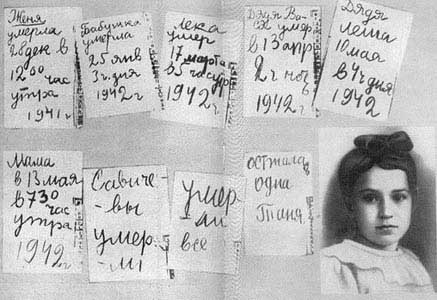Tanya Savicheva died near her hometown of Leningrad on 1 July 1944, aged only 14. Who was Tanya Savicheva? The name in Russia is what Anne Frank is to the West – a young innocent victim of World War Two, who left behind a small but lasting legacy.
 But whereas Anne’s diary is a carefully kept journal over a period of two years, Tanya’s was little more than a few scribbled lines over six sheets of notepaper.
But whereas Anne’s diary is a carefully kept journal over a period of two years, Tanya’s was little more than a few scribbled lines over six sheets of notepaper.
Leningrad Siege
Leningrad (modern-day St Petersburg) was in the midst of a devastating 900-day blockade that lasted from September 1941 until January 1944. The German army had laid siege to the city, bombarded it, and cut off all supplies in its attempt to ‘wipe it off the map’, as Hitler had ordered.
The Savicheva family had all answered the call to help bolster the city’s defences. Tanya, only 11 years old, helped dig anti-tank trenches. On 12 September 1941, the largest food warehouse, the Badayev, was destroyed, having been bombed with German incendiaries. Three thousand tonnes of flour burned, thousands of tons of grain went up in smoke, meat frazzled, butter melted, and sugar turned molten and seeped into the cellars. ‘The streets that night ran with melted chocolate,’ said one witness, ‘and the air was rich and sticky with the smell of burning sugar.’ The situation, already severe, became critical.
Road of Life
As winter approached, Lake Ladoga, to the east of the city, froze. From December 1941, supplies of foodstuffs, fuel and medicine came through by convoys of trucks, a hazardous journey over thin ice and through enemy bombardment. What was brought in on this ‘Road of Life’, although vital, was only ever a fraction of what was needed.
Within the city, as that first winter progressed, whatever could be eaten had been consumed – pets, livestock, birds, vermin. And whatever could be burnt had been used for firewood. Tanya had kept a thick diary but this, as with every other book in the household, had been used for fuel – except for a slim notebook.
The youngest of five children, Tanya Savicheva’s father died when she was six. Tanya, her mother and her five siblings, in common with every citizen of Leningrad during the siege, suffered terribly from hunger and cold. One winter’s day, Tanya’s sister Nina, 12 years older, failed to return. The family assumed that like so many hundreds of others, she had succumbed and died. In fact, Nina had been evacuated out of the city across Lake Ladoga at a moment’s notice. She returned to the city only after the war.
‘Savichevs died’
One by one, the remaining members of Tanya’s family died, and it was the recording of each death that constituted the notebook.
The first entry recorded the death of her sister, Zhenya, who died at midday on 28 December 1941. Others were to follow until the sixth and final death, that of Tanya’s mother, on 13 May 1942. A neighbour described the tragic figure of this young girl:
‘When Tanya lost everyone, she became deranged with grief. She would clutch at a small house plant, which had only a few withered leaves left, and was virtually dead. Somehow, it seemed to remind Tanya of her family. She would stand by her stove, swaying from side to side, holding it close to her, in a terrible trance. She was trying to bring it back to life.’
Tanya herself was eventually evacuated out of the city in August 1942, along with about 150 other children, to a village called Shakhty. But whilst most of the others recovered and lived, Tanya, already too ill, died of tuberculosis on 1 July 1944.
Her notebook was presented as evidence of Nazi terror at the post-war Nuremberg Trials, and today is on display at the History Museum in St Petersburg.
The text of Tanya’s notebook reads as follows:
Zhenya died on Dec. 28th at 12:00 P.M. 1941
Grandma died on Jan. 25th at 3:00 P.M. 1942
Leka died on March 5th at 5:00 A.M. 1942
Uncle Vasya died on Apr. 13th at 2:00 after midnight 1942
Uncle Lesha on May 10th at 4:00 P.M. 1942
Mother on May 13th at 7:30 A.M. 1942
Savichevs died.
Everyone died.

 Rupert Colley.
Rupert Colley.Read more about the war in The Clever Teens Guide to World War Two available as an ebook and 80-page paperback from Amazon, Barnes & Noble, Waterstone’s, Apple Books and other stores.